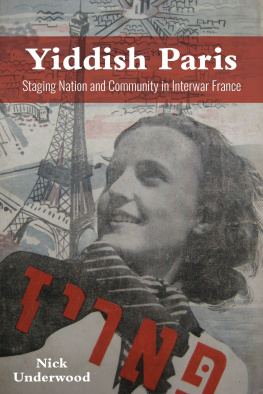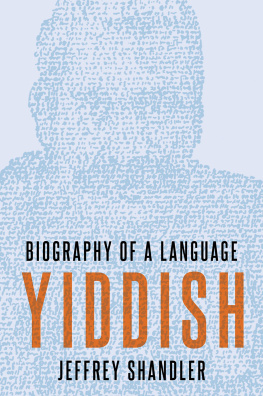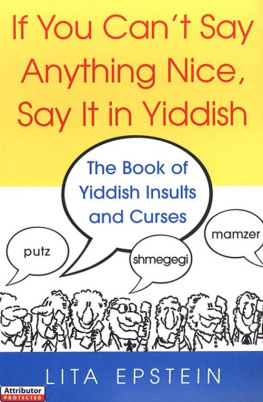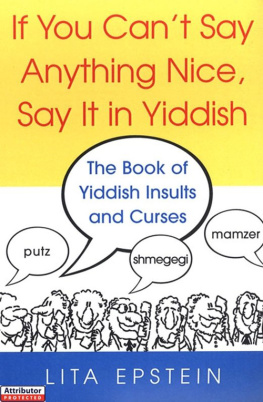contents
introduction
Oy, a lebn af dayn kop! Life on your head! This was my grandmothers favorite Yiddish blessing, which she showered on me whenever I did something appealing. A smile, a nod, an intelligent wordit didnt take much to earn life on my head, neither as a boy nor as a grown man.
Bobby, as we called her (a childish corruption of bobe, grandmother), lived to be ninety-seven and to embrace her great-grandchildren. They, too, experienced Yiddish as a kiss on the brow. The real vitality of the language, howeverits laughter, its anger, its insurgent brilliance, its gummy accentcould not and would not be a part of my kids future without Leo Rostens The Joys of Yiddish.
True, Bobbys mameloshn (mother tongue) has echoes all over the place: in college classrooms, on the Internet, on the theater and concert stage, at festivals and retreats. Still, the generations for whom Yiddish was a voice and not an echo are going if not gone, and the generation gap created by the Nazis crematoria has proved unbridgeable. As a result, Yiddish has just one viable survival strategyand Leo Rosten is its champion.
Rosten recognized that Yiddishkayt, the pathways and spirit of the language, was finding a new homeland in American culture. Unlike many Yiddish scholars, he delighted in this fact and treasured every Yiddish word or phrase, intonation or sentence structure, that had entered into English usage. Each, to his mind, was a carrier of the complete genetic code of Yiddish. In writing The Joys of Yiddish, Rosten was mapping the Yiddish genome.
The map was incomplete, of course. Rosten left out the double helix of modern Yiddish literature and poetry. He avoided the recombinant material of Yiddish political rhetoric and social criticism. He ignored most of the non-American strains of Yiddish culture. He chose humor, anecdote, and breezy erudition as his best tools because, as he wrote in his preface, a good story is exceedingly hard for anyone to forget. As a result, certain more sober Yiddishists were unhappy that Rosten, the kibitzer, won the commercial patent on Yiddish through the success of Joys. (A punch line from one of his many jokes might serve to express their attitude: Eh! If I had his voice, Id sing just as good!)
Patents do need periodic renewing, however. American life and Jewish life worldwide have all undergone tremendous transformations in the thirty-plus years since The Joys of Yiddish was published. My task has been to reflect some of these changes through a concise commentary on Rostens text. For example:
* When Rosten wrote, no women had been ordained as rabbis, nor had the nascent womens movement affected the organizational culture, ritual practice, or liturgy of the Jewish community. Today, womens representationthe adult bas mitzva, the creation of egalitarian prayer language, female inclusion in the minyan, the cantorate, the rabbinateis probably the most dynamic force in American Jewish life.
* When Rosten wrote, Israel was united by the victory of the Six-Day War, and Jewish identity was stirring to life worldwide, even in the heavily repressed Soviet Union. Today, Israel is divided by religious and political conflict, the Soviet Union is a memory, and nearly 20 percent of Israels population consists of recent Russian immigrants.
* When Rosten wrote, Reform and even Conservative Judaism were widely satirized as watered down versions of Judaism. Today, the Reform and Conservative denominations are flush with spiritual renewal and a return to tradition, and a fourth denomination, Reconstructionism, has grown to one hundred congregations.
* When Rosten wrote, cabala and Jewish mysticism were the exclusive provinces of Chasidic sects and Jewish historians. Today, Jewish mystical traditions have made a major comeback, riding the wave of spirituality that has drenched the baby boom generation and its younger siblings.
* When Rosten wrote, Jewish identity suffered from boredom, ennui, the attractions of assimilation, and the repressed memory of the Holocaust. Today, a renaissance in Jewish literacy, text interpretation, ritual innovation, creative arts, and Holocaust commemoration has fostered a revitalizationand reinventionof Jewish identity.
* When Rosten wrote, the final barriers to Jewish entry into the American mainstreamand Americas most elite circleswere eroding, largely as a result of the civil rights movement. Today, that entry is so compete that some 50 percent of Jews are intermarrying, and Jews are self-conscious about being overrepresented in Forbes magazines annual listing of the wealthiest Americans.
One other change has informed my work and leaves me in a state of apprehension. (Dem Yidns simkhe, says one Yiddish proverb, iz mit a bisl shrek: A Jews joy comes with a little fear.) When Rosten wrote, the amount of Jewish information available in English to a general readership was fairly skimpy. Today, there is as much free-floating Jewish knowledge between book covers and on the Internet as you could wantwhich will make my errors, and especially my omissions, seem all the more blatant. Hopefully, I have enough of my bobes easy blessings stockpiled to endure the embarrassment, and enough scholarly sensibility to want my mistakes consigned to oblivion rather than made authoritative by the reputation of Rostens book.
Very special thanks go to Gerald (Yankl) Stillman, upon whom I have relied heavily for commentary on Yiddish usage and derivations. I also would like to thank Madeline Lee and Margaret Muir, Leo Rostens daughters, for entrusting me with their fathers legacy.
The former president of the Reform synagogue movement, Rabbi Alexander M. Schindler, with whom I collaborated closely for the past sixteen years, died during the months when I was working on The Joys of Yiddish, and I would like to dedicate my portion of the book to his memory. Alex was the son of a Yiddish poet and led a life woven from incredibly diverse strands of Jewish experience. In Gan Eden, he and Leo Rosten are no doubt surrounded by the same flock of angels, eager for a tasty story.
Lawrence Busha
Accord, New York
preface
I wrote this book because there was no other way in which I could have it. For many years I had craved and sought and failed to find a lexicon of just this type.
What This Book Is Not
This is not a book about Yiddish. It is not a dictionary of Yiddish. It is not a guide to Yiddish. It is not written for experts in, or students of, Yiddish.
What This Book Is
This is a book about languagemore particularly, the English language. It shows how our marvelously resilient tongue has been influenced by another parlance: Yiddish. It illustrates how beautifully a language reflects the variety and vitality of life itself; and how the special culture of the Jews, their distinctive style of thought, their subtleties of feeling, are reflected in Yiddish; and how this in turn has enhanced and enriched the English we use today.
So, this book explores a fascinating aspect of English: those words and phrases from Yiddish (some I call Yinglish, some Ameridish) that we today encounter in English books, magazines, newspapers; or hear on television or radio, in movies or nightclubs; or may overhear on the street or in a bus in many a large city in the United States.
By Yinglish I mean Yiddish words that are used in colloquial English in both the United States and the United Kingdom: kibitzer, mish-mash, bagel, etc.
By Ameridish I mean words coined by, and indigenous to, Jews in the United States:







